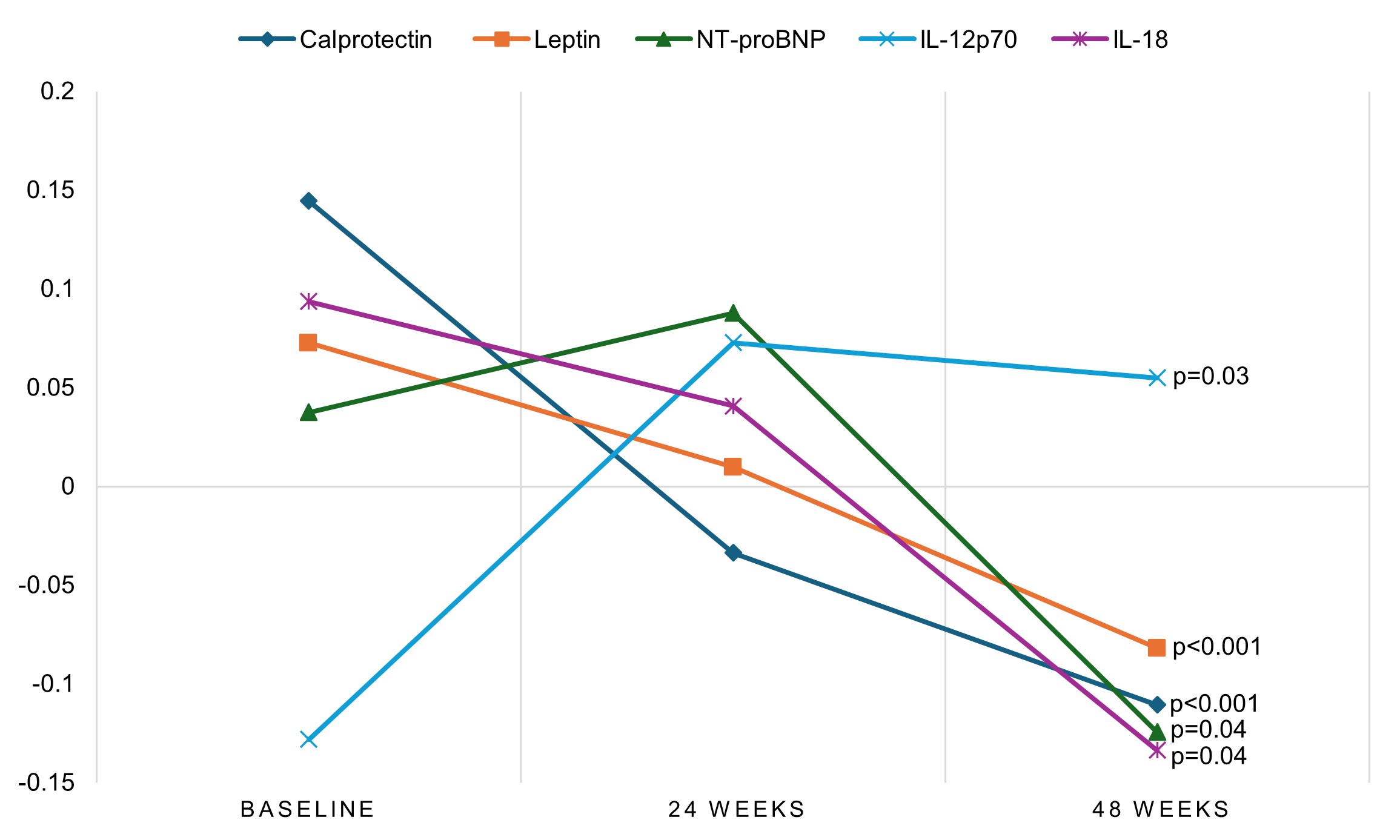Session Information
Date: Monday, November 18, 2024
Title: Metabolic & Crystal Arthropathies – Basic & Clinical Science Poster III
Session Type: Poster Session C
Session Time: 10:30AM-12:30PM
Background/Purpose: Gout is the most common inflammatory arthritis worldwide and is associated with substantial cardiometabolic morbidity and mortality. In the STOP Gout trial (O’Dell JR et al. NEJM Evid 2022), participants with gout receiving treat-to-target urate-lowering therapy (ULT) with allopurinol or febuxostat experienced significant reductions in C-reactive protein concentrations during the 72-week study. Whether treat-to-target ULT or anti-inflammatory prophylaxis reduces other measures of subclinical inflammation implicated in cardiometabolic disease is unknown. In this study, we examined changes in inflammatory biomarkers in patients on ULT and whether changes observed were associated with specific ULT agent and/or anti-inflammatory prophylaxis administered.
Methods: We included a subset of participants from the STOP-Gout study (total enrollment=940), all of whom met classification criteria for gout, had been randomized to allopurinol or febuxostat, received anti-inflammatory prophylaxis for 6-12 months, and had banked biosamples available from baseline, 24-, and 48-week visits. We measured a panel of 20 circulating biomarkers using commercially available assays, which included inflammatory cytokines, chemokines, adipokines, and cardiac analytes selected based on published associations with gout or reports demonstrating decreases on ULT. Biomarkers were normalized via log-transformation for models and standardized for graphical comparison of trends. Changes in individual biomarkers from baseline were evaluated using generalized estimating equations. Factors assessed as possible determinants of biomarker change included baseline demographics and co-morbidities, as well as ULT agent, prophylaxis (use and agent), and serum urate (sUA) concentration over time throughout the trial. ULT and prophylaxis at baseline were not considered relevant, as these agents had not been started at the time of lab draw.
Results: Participants included in this analysis (n=282) had a mean age of 70.0 years, and were predominantly male (96.4%), reported White race (75.2%), and were overweight/obese (mean BMI 33.1 kg/m2). Mean sUA at enrollment was 8.5 mg/dl and 91% used colchicine for prophylaxis. Of the 20 biomarkers evaluated, five changed significantly over time when accounting for covariates (Figure 1). Four of these (calprotectin, leptin, N-terminal pro-B-type natriuretic peptide [NT-proBNP], and IL12p70) were also affected by prophylactic agents, although this was variable by analyte and time point.
Conclusion: Select inflammatory biomarkers (calprotectin, leptin, NT-proBNP, IL12p70, and IL-18) significantly change during treatment with ULT via a treat-to-target approach. These findings suggest that ULT may provide important systemic benefits through long-term anti-inflammatory effects beyond reducing the burden of acute flares. These results provide additional support for the importance of effective management of ULT via a treat-to-target approach.
No change over time in lactotransferrin, MCP_1, IL_1RA, MPO, IL-6, GM-CSF, troponin, IL_1β, IFNα, adiponectin, TNF, FGF_21, IL-8, MIP_1, or oxidized LDL. Biomarkers normalized for comparison (mean 0, standard deviation 1). P values represent change over time from baseline via generalized estimating equations.
Abbreviations: N-terminal pro-B-type natriuretic peptide (NT-proBNP), interleukin (IL), monocyte chemoattractant protein (MCP), IL_1RA (interleukin_1 receptor antagonist), myeloperoxidase (MPO), granulocyte-monocyte stimulating factor (GM-CSF), interferon (IFN), tumor necrosis factor (TNF), fibroblast growth factor (FGF), low density lipoprotein (LDL), macrophage inflammatory protein (MIP)
To cite this abstract in AMA style:
Wheeler A, Ourada T, Duryee M, England B, Reynolds R, O'Dell J, Newcomb J, Pillinger M, Terkeltaub R, Ferguson R, Brophy M, Merriman T, Mikuls T. The Influence of Treat-to-target Urate Lowering Therapy and Anti-inflammatory Prophylaxis on Circulating Measures of Inflammation in Gout [abstract]. Arthritis Rheumatol. 2024; 76 (suppl 9). https://acrabstracts.org/abstract/the-influence-of-treat-to-target-urate-lowering-therapy-and-anti-inflammatory-prophylaxis-on-circulating-measures-of-inflammation-in-gout/. Accessed .« Back to ACR Convergence 2024
ACR Meeting Abstracts - https://acrabstracts.org/abstract/the-influence-of-treat-to-target-urate-lowering-therapy-and-anti-inflammatory-prophylaxis-on-circulating-measures-of-inflammation-in-gout/

